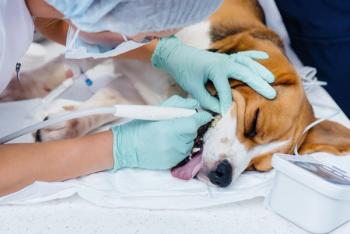
Ultrasonography of the reproductive tract (Proceedings)
Radiology and ultrasonography are useful for evaluating the ovaries, uterine wall, and intrauterine contents; for confirming pregnancy; and for assessing fetal viability.
Radiology and ultrasonography are useful for evaluating the ovaries, uterine wall, and intrauterine contents; for confirming pregnancy; and for assessing fetal viability. The normal uterus and ovaries in a nonpregnant animal are not detected by routine abdominal radiography. During normal anestrus they may be difficult to identify by ultrasonography. Increased size and density and an abnormal shape of the uterus may be detected by either technique. Ultrasonography can be used to evaluate the uterine wall and the intrauterine contents. Ultrasonography may also help identify ovarian remnants, or ovarian cysts in animals with persistent estrus and hyperestrogenism (follicular cysts) or persistent anestrus (nonfunctional or luteal cysts). It may be able to identify ovarian neoplasia as well. Negative findings with diagnostic imaging do not necessarily exclude disease in the reproductive tract, especially in females.
Because of the difficulty involved in catheterizing the cervix, contrast studies of the uterus and uterine tubes (i.e., hysterosalpingography) are rarely done in bitches and queens. During estrus, contrast material deposited in the cranial vagina may enter the uterus and provide a hysterogram, but at other stages of the cycle, the cervix is normally closed. Positive-contrast vaginography, using a Foley catheter and a water-soluble contrast agent (e.g. diatrizoates such as Renografin®), is easily performed, but general anesthesia is necessary. Vaginography can be considered if vaginoscopy fails to clearly identify strictures, anatomic defects, masses, or foreign material in the vagina.
In the evaluation of male reproductive disorders, radiography is used primarily to assess the size of the prostate gland and to identify metastatic lesions in dogs with suspected prostatic adenocarcinoma. Ultrasonography is very useful to identify and characterize lesions within the prostate, testis, and epididymis; to help determine the cause of testicular or scrotal swelling; to assess the character of the spermatic cord in suspected cases of torsion; and to help establish the location of undescended testes. Ultrasonography is routinely used to guide biopsy needles for obtaining specimens from the prostate gland and focal lesions within the testis or epididymis.
Examples of normal and abnormal findings on ultrasound examination of the male and female reproductive tract will be shown.
From: Johnson CA, Reproductive System Disorders. In: Nelson RW and Couto CG (eds) Small Animal Internal Medicine 4th edition. St. Louis, Elsevier
Newsletter
From exam room tips to practice management insights, get trusted veterinary news delivered straight to your inbox—subscribe to dvm360.




